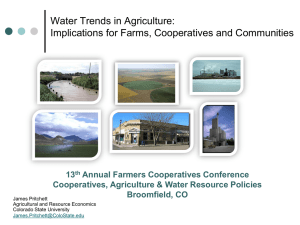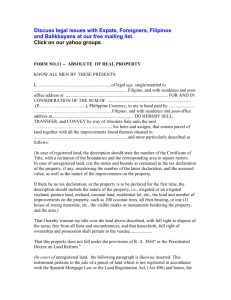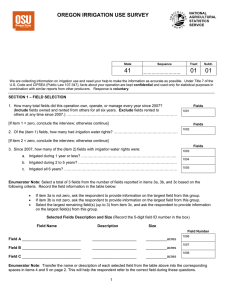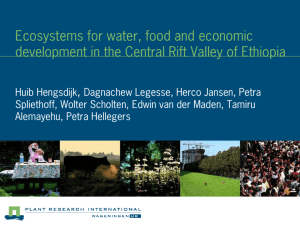USING GIS TO ESTIMATE AGRICULTURAL ... Anthony Morse
advertisement
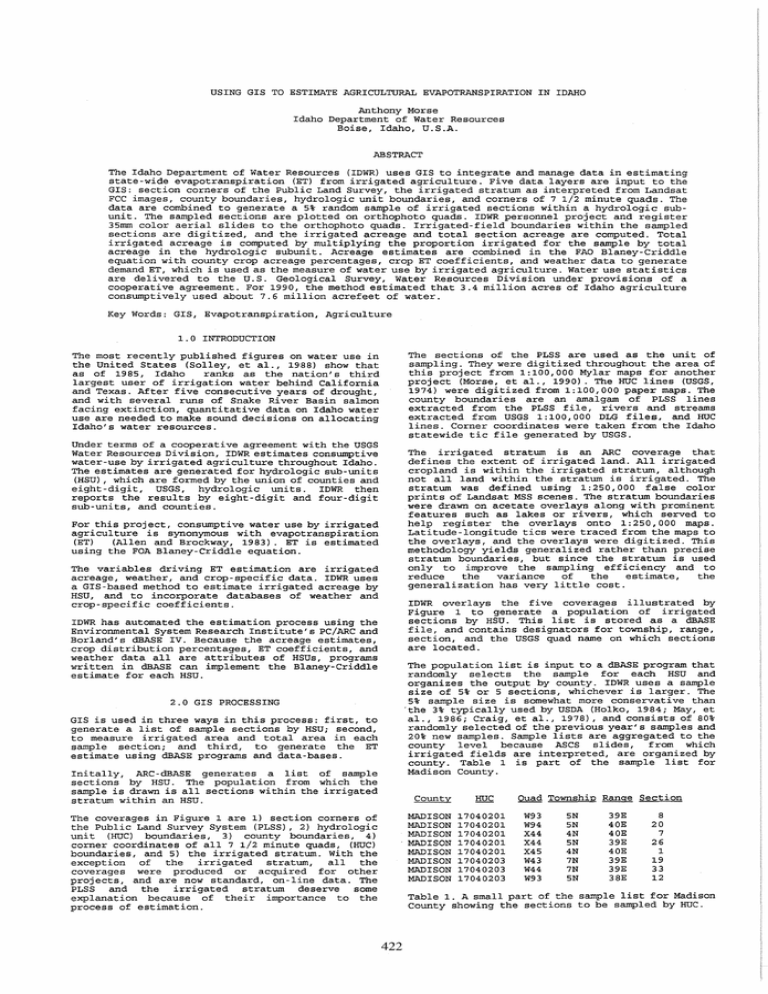
USING GIS TO ESTIMATE AGRICULTURAL EVAPOTRANSPIRATION IN IDAHO Anthony Morse Idaho Department of Water Resources Boise, Idaho, U.S.A. ABSTRACT The Idaho Department of Water Resources (IDWR) uses GIS to integrate and manage data in estimating state-wid~ evapotranspiration (ET) from irrigated agriculture. Five data layers are input to the GIS: sect~on corners of the Public Land Survey, the irrigated stratum as interpreted from Landsat FCC images, county boundaries, hydrologic unit boundaries, and corners of 7 1/2 minute quads. The da~a are combined to g~nerate a 5% random sample of irrigated sections within a hydrologic subun~t. The sampled sect~ons are plotted on orthophoto quads. IDWR personnel project and register 35mm color aerial slides to the orthophoto quads. Irrigated-field boundaries within the sampled ~ec~ions are digitized, and the irrigated acreage and total section acreage are computed. Total ~rr~gated acreage is computed by multiplying the proportion irrigated for the sample by total acreage in the hydrologic subunit. Acreage estimates are combined in the FAO Blaney-Criddle equation with county crop acreage percentages, crop ET coefficients, and weather data to generate demand ET, which is used as the measure of water use by irrigated agriculture. Water use statistics are delivered to the U. S. Geological Survey, Water Resources Division under provisions of a cooperative agreement. For 1990, the method estimated that 3.4 million acres of Idaho agriculture consumptively used about 7.6 million acrefeet of water. Key Words: GIS, Evapotranspiration, Agriculture 1.0 INTRODUCTION The sections of the PLSS are used as the unit of sampling. They were digitized throughout the area of this project from 1:100,000 Mylar maps for another project (Morse, et al., 1990). The HUC lines (USGS, 1974) were digitized from 1:100,000 paper maps. The county boundaries are an amalgam of PLSS lines extracted from the PLSS file, rivers and streams extracted from USGS 1: 100,000 DLG files, and HUC lines. Corner coordinates were taken from the Idaho statewide tic file generated by USGS. The most recently published figures on water use in the United States (Solley, et al., 1988) show that as of 1985, Idaho ranks as the nation's third largest user of irrigation water behind California and Texas. After five consecutive years of drought, and with several runs of Snake River Basin salmon facing extinction, quantitative data on Idaho water use are needed to make sound decisions on allocating Idaho's water resources. Under terms of a cooperative agreement with the USGS Water Resources Division, IDWR estimates consumptive water-use by irrigated agriculture throughout Idaho. The estimates are generated for hydrologic sub-units (HSU) , which are formed by the union of counties and eight-digit, USGS, hydrologic units. IDWR then reports the results by eight-digit and four-digit sub-units, and counties. The irrigated stratum is an ARC coverage that defines the extent of irrigated land. All irrigated cropland is within the irrigated stratum, although not all land within the stratum is irrigated. The stratum was defined using 1: 250,000 false color prints of Landsat MSS scenes. The stratum boundaries were drawn on acetate overlays along with prominent features such as lakes or rivers, which served to help register the overlays onto 1: 250,000 maps. Latitude-longitude tics were traced from the maps to the overlays, and the overlays were digitized. This methodology yields generalized rather than precise stratum boundaries, but since the stratum is used only to improve the sampling efficiency and to reduce the variance of the estimate, the generalization has very little cost. For this project, consumptive water use by irrigated agriculture is synonymous with evapotranspiration (ET) (Allen and Brockway, 1983). ET is estimated using the FOA Blaney-Criddle equation. The variables driving ET estimation are irrigated acreage, weather, and crop-specific data. IDWR uses a GIS-based method to estimate irrigated acreage by HSU, and to incorporate databases of weather and crop-specific coefficients. IDWR overlays the five coverages illustrated by Figure 1 to generate a population of irrigated sections by HSU. This list is stored as a dBASE file, and contains designators for township, range, section, and the USGS quad name on which sections are located. IDWR has automated the estimation process using the Environmental System Research Institute's PC/ARC and Borland's dBASE IV. Because the acreage estimates, crop distribution percentages, ET coefficients, and weather data all are attributes of HSUs, programs written in dBASE can implement the Blaney-Criddle estimate for each HSU. The population list is input to a dBASE program that randomly selects the sample for each HSU and organizes the output by county. IDWR uses a sample size of 5% or 5 sections, whichever is larger. The 5% sample size is somewhat more conservative than 'the 3% typically used by USDA (Holko, 1984; May, et al., 1986; Craig, et al., 1978), and consists of 80% randomly selected of the previous year's samples and 20% new samples. Sample lists are aggregated to the county level because ASCS slides, from which irrigated fields are interpreted, are organized by county. Table 1 is part of the sample list for Madison County. 2.0 GIS PROCESSING GIS is used in three ways in this process: first, to generate a list of sample sections by HSU; second, to measure irrigated area and total area in each sample section; and third, to generate the ET estimate using dBASE programs and data-bases. Initally, ARC-dBASE generates a list of sample sections by HSU. The population from which the sample is drawn is all sections within the irrigated stratum within an HSU. County MADISON MADISON MADISON MADISON MADISON MADISON MADISON MADISON The coverages in Figure 1 are 1) section corners of the Public Land Survey System (PLSS), 2) hydrologic unit (HUC) boundaries, 3) county boundaries, 4) corner coordinates of all 7 1/2 minute quads, (HUC) boundaries, and 5) the irrigated stratum. With the exception of the irrigated stratum, all the coverages were produced or acquired for other projects, and are now standard, on-line data. The PLSS and the irrigated stratum deserve some explanation because of their importance to the process of estimation. HUC 17040201 17040201 17040201 17040201 17040201 17040203 17040203 17040203 Ouad Township Range Section W93 W94 X44 X44 X45 W43 W44 W93 5N 5N 4N 5N 4N 7N 7N 5N 39E 40E 40E 39E 40E 39E 39E 38E 8 20 7 26 1 19 33 12 Table 1. A small part of the sample list for Madison County showing the sections to be sampled by HUC. 422 Madison Co. PUS Sections p: f" weather stations throughout the state. Stations were chosen to be as representative as possible for the HUC in which they are located. By using a network of stations, IDWR can account for much of the climatic variation found throughout the state. The weather file lists the mean monthly temperature and total monthly precipitation for each station. ,.. Just as temperature varies across Idaho, so does the mix of crops grown in each county. IDWR uses cropacreage proportions on a county-by-county basis as input to adjust the Blaney-Criddle estimate. These proportions are reported by each county ASCS office as part of their role in assuring accurate acreagecounts for compliance with crop-support programs. The data are then ready for the third GIS application: using equations and data-bases of cropacreage proportions, weather, and crop ET coefficients by HSU to compute consumptive wateruse. Figure 2 illustrates the process. 5.0 ACREAGE ESTIMATION IDWR has adapted a method originally developed by the USDA Statistical Reporting Service to estimate irrigated acreage. The USDA method is called "Direct Expansion" (Holko and Sigman, 1984), and is based on sampling. Direct Expansion and IDWR's methodology share two basic characteristics: both use PLSS sections as the sampling unit, and use stratification to increase the efficiency of the sampling. IDWR has implemented the process in ARC and dBASE. Madison Co. Irrigated Stratum Data processing for acreage estimation begins with the orthophoto quads that are brought back from the ASCS offices. Each sampled section is drawn on the OQs and divided into polygons labled as irrigated or non-irrigated. The polygons are digitized from the OQs to generate an ARC coverage. Figure 1. Single county example of the five statewide coverages ARC uses to build sampling lists. The color, aerial photography in the form of slides is interpreted to determine whether or not fields in the sample sections are irrigated. Every year, ASCS offices contract for 35 rom aerial slides of the agricultural land in each county. The photos help verify acreages for crop support programs. All Irrigated Areas by County, Hydrolog1c Units and Quads. IDWR personnel begin the interpretation process by travelling to ASCS offices in each county having irrigated land. Photointerpreters use the ASCS slides to identify irrigated fields with-in sample sections, and to delineate boundaries of the irrigated fields on an orthophotoquad (OQ). The first step is to project the slide covering a sampled section onto an OQ. Next, the projected image of the section is carefully registered to the OQ, and boundaries of the irrigated fields are traced onto the OQ. by HSU Randomly Select 1------.------tAerial Sl ides Digitize Sample Sections by County Union with Strata Digitized Sample Sections by HSU ASCS schedules its photo missions for early July when small-grain crops are easy to identify, and other Idaho crops have enough cover to identify them as irrigated. When ambiguities do arise, the ASCS county agents provide valuable insight into local conditions that usually clear up the issue. When field boundaries of all the sampled sections have been drawn, the OQs are returned to IDWR for final GIS processing. Compute Irrigated and Total Acreage per Section by HSU by HSU ARC and dBASE functions combine to measure and organize the irrigated area of the sampled sections, and the total area of the irrigated stratum in each HSU. The orthophoto quads that come back from the county ASCS offices are digitized in ARC, and the irrigated and total acres, by section, are stored by HSU. The area of the irrigated stratum is output from the intersect that created the HSU coverage. Compute Reference ET Crop Water Use Coefficients Compute Crop croP1ET For each section, IDWR personnel digitize the section boundary to compute total section area, and digitize the boundaries of each irrigated field within the section. All areas not labeled as irrigated are labeled as non-irrigated. The new fields in the sample list carry the acreage irrigated and the total acreage for each section. Total ET by HSU Figure 2. Flow estimation. Weather data are the primary drivers of the BlaneyCriddle equation. The equation needs daily minimum and maximum temperatures to compute ET. IDWR inputs the mean monthly temperatures from ninety-eight NOAA chart showing the steps in ET Irrigated acreage for each HSU is estimated by computing the mean percentage of irrigated land in the sampled sections, and multiplying that figure by 423 The Blaney-Criddle equation is implemented in dBase programs that draw on four data-bases. These databases contain 1) mean monthly and total monthly precipitation, 2) coefficients to describe the micro- and macro-climate of each weather station, 3) coefficients to adjust individual crop ETo to each weather station, and 4) the proportion of individual irrigated crops to total irrigated agriculture in each county. th7 t?tal a~ea of the irrigated stratum in the HSU. Th~s ~s equ~valent to calculating the mean irrigated ~roportion for an HSU. Since simple, random sampling ~s ~sed, th~ mean and variance of the sample are unb~ased est~mators of the mean and variance of the pop';llation from which the sample is drawn. The est~mates are generated in dBASE IV using formulas based on those developed by USDA (Holko and Sigman 1984) and modified by IDWR personnel. ' The formula for estimating irrigated acreage in an HSU is The first two databases are used in the BlaneyCriddle equation, which Allen and Brockway (1983) ~escribe in detail. The result of using those data ~s to adjust each ETo for the aridity, elevation, hours of sunlight, and average wind at each weather station. ETo is also corrected for precipitation by subtracting the total monthly precipitation. (1) Y Subsequent steps implemented in DBASE adjust ETo to total ET using crop proportions and coefficients. The total irrigated acres in an HSU are multiplied by the proportion of total irrigated acres in each crop type to get crop acreage. Each HUC's ETo is multiplied by crop-specific coefficients to derive a crop-specific ET. Total crop ET is the product of the crop-specific ET and total crop acres. Total ET for an HSU is the sum of the total ET by crop. Table 2 summarizes the estimates of both irrigated acres and water use by county for the 1990 growing season. where n estimated irrigated acreage per HSU the number of irrigated acres in sampled section, j the total acres in sampled section, j total number of sections in the irrigated stratum number of sections sampled in the irrigated stratum This process yielded an estimate of approximately 3.41 million irrigated acres for the 1990 growing season. Table 2 summarizes the irrigated acreage by county. COUNTY ADA ADAMS BANNOCK BEAR LAKE BENEWAH BINGHAM BLAINE BOISE BONNER BONNEVILLE BOUNDARY BUTTE CAMAS CANYON CARIBOU CASSIA CLARK CLEARWATER CUSTER ELMORE FRANKLIN FREMONT GEM GOODING IDAHO JEFFERSON JEROME KOOTENAI LATAH LEMHI LEWIS LINCOLN MADISON MINIDOKA NEZ PERCE ONEIDA OWYHEE PAYETTE POWER SHOSHONE TETON TWIN FALLS VALLEY WASHINGTON Once the total acreage for each HSU is estimated the est~mate is combined with data on crop-acreag~ proport~ons by county, ground crop-specific ET coefficients, and temperature by HSU to estimate ET by HSU. 4.0 ESTIMATING EVAPOTRANSPIRATION ET is estimated using the FAO Blaney-Criddle method as adapted specifically for Idaho by Allen and Brockway (1983) . While a more data-intensive method such as the modified Penman may provide a mor~ a?curat~ estima~e.of ET, the scarcity of monitoring s~tes w~th suff~c~ent data prohibits the use of the Penman equation on a state-wide basis. The Idahoadapted FAO Blaney-Criddle equation uses mean monthly air temperature to compute a reference, or potent~al, ET. Potential ET is then multiplied by an appropriate crop coefficient to output crop ET which is used as the measure of water use. ' Allen and Brockway (1983) derived crop coefficients for seventeen common Idaho crops for each of the ninety-eight NOAA weather stations around the state that are used to estimate ET. The coefficients are based on work done by Wright (1982) at the USDA research station at Kimberly, Idaho. IDWR applied the above described estimation technique in Idaho for the 1989 growing season. The pro?edure estimated that Idaho's irrigated agr~culture used about 9.34 million acre feet of water during the 1989 growing season. Allen and Brockway Criddle as (1983) show the FAO Blaney- E~=(a+b[p(0.46T+8.13)])*(1.0+E/1000) (2) where TOTAL ETo = grass reference ET in mm per day; a = intercept to adjust estimate based on minimum relative humidity and ratio of actual to possible hours of sunshine; b adjustment factor based on minimum relative humidity and ratio of actual to possible hours of sunshine and mean daytime wind speed in meters per second at each weather site; p mean percentage of total annual daytime hours for a given month and latitude; T mean daily temperature in degrees Celsius for each month; E elevation in meters. ACRES 94.2 14.0 3l.1 15.5 0.6 326.9 55.1 0.4 5.0 152.0 2.3 40.8 75.1 243.9 85.0 232.3 58.8 0.1 40.7 9l.7 40.1 123.6 37.4 154.0 3.9 193.3 162.5 17.9 3.1 46.6 0.0 88.1 105.6 163.0 2.9 40.4 109.9 68.6 62.8 0.0 63.5 288.1 4l.4 34.0 3,416.2 USE 32.6 29.7 71.4 29.5 3.0 751.5 39.2 3.1 6.3 322.6 0.7 86.6 210.3 65l.8 168.7 560.3 113.3 0.1 96.3 23l.8 33.2 238.0 107.7 228.4 6.7 423.7 369.8 12.5 0.1 53.0 0.0 244.5 214.3 360.8 7.2 30.2 255.4 19l.9 137.4 0.0 130.4 664.1 74.4 76.8 7,562.9 Table 2. Irrigated acreage in thousands of acres, and consumptive use in thousands of acrefeet, by irrigation in Idaho for 1990. Acreage is listed by method of irrigation. 5.0 SOURCES OF ERROR The method IDWR uses to estimate water use is imprecise due to sampling and other errors. These errors fall into three broad categories: 1) errors in the basic assumptions of the process; 2) errors in the estimation of irrigated acreage; and 3) 424 ,errors in the coefficients used to compute ET. the union of counties and USGS hydrologic units. PC ARC is used to digitize irrigated fields and total area for each sampled section. By intersecting HUCs, counties and the irrigated stratum, ARC generates the total area of the irrigated stratum in each HSU. The percentage of irrigated land in the sample is multiplied by the total area of the irrigated stratum in an HSU to estimate the total number of irrigated acres in an HSU. One of the fundamental assumptions in the use of ET as a measure of consumptive water-use is that crops are well-watered and disease-free. This assumption is not universally met in Idaho Agriculture. The issue of disease-free crops is too difficult to quantify. The availability of water is also difficult to factor, but is much better understood. While the great majority of irrigated fields in Idaho have enough water throughout the growing season, some do not. Shortages of water can be due to drought, as in the Big Wood River system below Magic Reservoir, or to a lack of storage, as on many small creeks at higher elevations that are used mainly to irrigate pasture. IDWR uses the FAO Blaney-Criddle equation to estimate evapotranspiration. The equation uses as input HUC and county- specific data including irrigated acreage, temperature, wind, crop acreage proportions, and crop ET coefficients that have been developed for specifically for Idaho. In 1990, this process estimated that approximately 7.6 million acre feet of water were used in Idaho to irrigate approximately 3.4 million acres. The number of fields suffering from drought in any given year is both highly variable and difficult to quantify, but in 1990, the acreage was limited, probably no more than 50,000 acres. While the magnitude of this error is large due to the generally high temperatures where shortages occur, the area is only about 1.5% of the total irrigated acreage. The effect of this source of error on the total water-use estimate is correspondingly small. 7.0 REFERENCES Allen, R. G. and C. E. Brockway, 1983. Estimating consumpti ve irrigation requirements for crops in Idaho. Report of the Idaho Water and Energy Resources Research Institute, Univ. of Idaho, Moscow, ID-USA. The acreage that is irrigated from sources without storage is also difficult to estimate, but it probably represents less than 10% of the total irrigated area in Idaho, or fewer than 300,000 acres. The error in the water-use estimate from this source is limited because most of this land is not included in the irrigated stratum. Craig, M. E., M. Cardenas, and R. S. Sigman, 1978. Area estimation by Landsat: Kansas 1976 winter wheat. Report of the Economics, Statistics, and Cooperatives Service, U.S. Department of Agriculture. Washington, DC-USA. Errors in the estimation of the irrigated area also result from some of the high-altitude, irrigated pasture being excluded from the irrigated stratum, and from errors in the photointerpretation of irrigated versus non-irrigated fields. However, these errors are relatively small. Holko, M. L. and R. S. Sigman 1984, The role of Landsat data in improving U.S. crop statistics. In: Proceedings of the 18th International Symposium on Remote Sensing of Environment, Paris, France. Holko, M. L., 1984. 1982 Results for the California cooperative remote Sensing project. Statistical Reporting Service, u.S. Department of Agriculture, Washington, DC-USA. The boundaries of the irrigated stratum were drawn from 1:250,000, Landsat, false-color-composite prints. On those prints, the irrigated agriculture found on the Snake River Plain is clearly evident due to large, regular fields that contrast well with the surrounding rangeland. The small, irregular, irrigated meadows at higher elevations cannot be reliable discriminated from non-irrigated meadows or from much of the other surrounding vegetation. However, since there is no water storage for the.se areas, and the temperatures are cooler than at lower altitudes, the water-use by these fields is relatively small, certainly less than 1% of total irrigation water-use. May, G., M. Holko, and N. Jones, 1986. 1983 Missouri crop and landcover study. NABS Staff Report RSB-86-01, U.S. Department of Agriculture, Washington, DC-USA. Morse, A., T.J. Zarriello, and W.J. Kramber, 1990. Using remote sensing and GIS technology to help adjudicate Idaho water rights. Photogrammetric Engineering and Remote Sensing, 61(3) :365-370. Solley, W. B., C.F. Merk, and R.R. Pierce, 1988. Estimated use of water in the United States in 1985. U. S. Geological Survey Circular 1004. U. S. Government Printing Office, Washington, DC-USA. Sampling error in the acreage total can be estimated using formulas provided by Holko and Sigman (1984). A variance was not calculated as part of the 1990 analysis, but county acreage figures were compared to the 1987 Census of Agriculture using leastsquares regression. The coefficient of determination between the two estimates was r2 = .96, which implies a relatively small error in the estimate of irrigated acres. The error contributed by errors in the water-use coefficients are relatively difficult to quantify. Allen and Brockway (1983) modified their coefficients specifically for Idaho, but provided no analysis of their accuracy. The total combined error from the above sources probably has approximately a 10% to 15% effect on the final water-use estimate for the state. However, since the error is not evenly distributed among HSUs, error in the water-use estimate for individual HSUs could be significantly higher. 6.0 SUMMARY The Idaho Department of Water Resources estimates annual water use for the State of Idaho, including that for irrigated agriculture. IDWR uses PC-ARC and dBASE IV to manage five graphic, spatial data-layers and other non-graphic but spatially-referenced data. These data are combined with GIS to generate a sample suite of Township and Range sections. The sample is drawn from the irrigated stratum within each hydrologic sub-unit (HSU). An HSU is formed by 425
